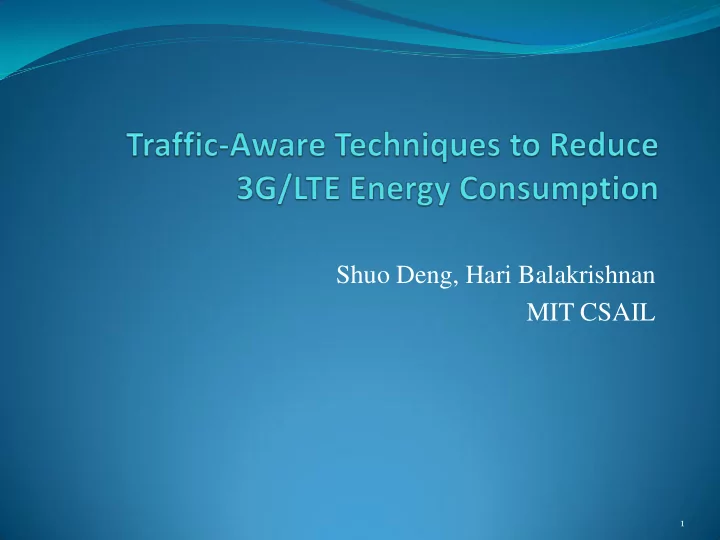

Shuo Deng, Hari Balakrishnan MIT CSAIL 1
Problem: 3G/LTE is a battery hog “Up to 14 hours on 2G” “Up to 6.5 hours on 3G” 100% 90% 80% 70% Energy Percentage 60% 50% 40% 30% 20% 10% 0% Goal: Reduce Energy News IM Micro-blog Game Email Social Finance Network Consumption Data Active, No Data High PowerIdle State Switch 2
Context: Radio Resource Control Inactivity Timer t 1 Cell_DCH (Active) Cell_FACH Cell_PCH/IDLE (High Power Idle) (Idle) Inactivity Timer t 2 3
t 1 Active Power Consumption High Power IDLE Idle t 2 t 1 t 2 IDLE IDLE 4
Fast Dormancy Inactivity Timer t 1 Active High Power Idle Idle Inactivity Timer t 2 Idle Active 5
Idle Active Challenges Switching between states takes time(1~3 seconds), and consumes energy Signaling overhead t1 t2 IDLE IDLE 6
Contributions A traffic-aware design to control radio state transitions to reduce energy consumption MakeIdle: when to switch to Idle MakeActive: when to switch to Active MakeActive Idle Active MakeIdle Experimental evaluation on real usage data Energy reduction up to 75% across different carriers 7
System Design Active Idle App1 App2 App3 Control Socket Module Calls Packet/Socket Call Switch to Idle Information Modified Socket Layer Switch to Active Fast Data Dormancy Interface Trigger Fast Dormancy 3G Radio 8
t1 t2 IDLE IDLE Power time 9
Active Idle MakeIdle Algorithm MakeIdle Power Power time time IAT Inter Arrival Time > , should switch to Idle mode to If minimize the energy consumption. If IAT > threshold , should switch to Idle mode. 10
Active Idle MakeIdle Algorithm MakeIdle Predict whether the IAT will be greater than threshold Wait for a short period of time t wait , if no packet comes, then put the radio to Idle mode Why: the longer the network is idle, the longer it is likely to remain idle 11
Active Idle MakeIdle: Picking t wait MakeIdle … P(IAT>t+threshold | IAT>t ) Previous N packets ( Energy Energy ) state _ switch no _ state _ switch 12
Power Current Scheme time Power With MakeIdle time Power With MakeActive time 13
MakeActive Active Idle MakeActive Algorithm Reduce the number of state switches by introducing a small delay when the radio is in Idle mode and data transmission requests come from the mobile device side How much delay for each request? Fixed delay bound Learning algorithm 14
Evaluation Setup Energy profiling Power consumption profiles for 4 US major carriers: AT&T, Verizon, T-Mobile, Sprint Trace driven simulation Tcpdump traces for real usage data, collected from 9 users, 28 days in total 15
Evaluation: MakeIdle 40x 80 95% IAT across users 35x 70 Energy Saved (%) Increased Signaling 95% IAT per user 30x 60 MakeIdle Overhead 25x 50 Prior knowledge of IAT 40 20x (Oracle) 30 15x 20 10x 10 5x 0 0 1 2 3 -10 1 2 3 User ID User ID 16
Active Idle Evaluation: MakeIdle MakeIdle Prediction Accuracy 95% IAT across users FP 95% IAT across users FN 95% IAT per user FP 30 95% IAT per user FN False Positive (FP) or 25 False Negative (FN) MakeIdle FP MakeIdle FN 20 15 10 5 0 1 2 3 User ID 17
Evaluation: Different Carriers 80 70 Energy Saved (%) 60 95% IAT across users 50 95% IAT per user 40 MakeIdle 30 MakeIdle+MakeActive 20 10 0 T-Mobile AT&T Verizon 3G Verizon LTE -10 Carriers 18
Related Work Inactivity timer reconfiguration Statistical method [Falaki et al, 2010]: 95 percentile packet inter arrival time Applications-Involved Design TailEnder [Balasubramanian et al, 2009]: each application specifies its delay tolerance TOP [Qian et al, 2010]: application predict the gap between its own traffic transmissions TailTheft [Liu et al, 2011]: application specifies delay tolerance and predicts transmission duration 19
Conclusion A traffic-aware design to control state transitions of 3G/LTE radio to reduce energy consumption on mobile devices Require no modifications of the applications Save 3G/LTE energy consumption by up to 75% across different carriers 20
Recommend
More recommend